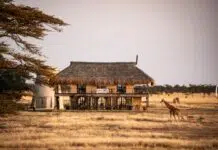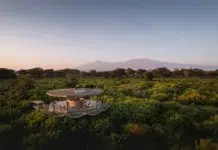Starting in the west at Tubu Tree before heading east to Mokete, concluding with King’s Pool in the north of Botswana, the trifecta of lodges is an ideal combination to experience the supreme luxury of Wilderness.
Tubu Tree
The Okavango Delta. One of the most pristine wilderness areas on the planet. It’s a bucket list destination for many past, present, and prospective visitors. Situated on the western fringe of the Delta, Tubu Tree sits within the private Jao Reserve. A diverse variety of habitats is present, from palm-dotted floodplains to lush, riverine forests. The annual floods from Angola turn the landscape into a watery wonderland as the tributaries start filling with life-enhancing liquid. This occurrence makes wildlife flock to the spectacular part of Botswana.

It’s a short 35-minute flight from Maun International Airport with Wilderness Air. Captain Botshelo flies the Cessna 208 and lands the fixed-wing aircraft on the Hunda airstrip. Guide Bino collects me and drives me to Tubu Tree, which is only five minutes away. Warmly welcomed by the staff, I’m shown to my Tented Suite for the next two nights. After High Tea, we depart on a game drive to see the wildlife that inhabits this concession.

A large bull elephant is sprinkling himself with dust. It’s clear from the darker spots on his body that he has recently enjoyed a mud bath. On the opposite side of the game path, the matriarch is pointing her trunk in the air. The rest of the elephants follow her lead, and it’s entertaining to watch the calves doing the same. They haven’t quite managed how to use their trunks, as it takes a certain amount of skill. A calf suddenly breaks away from the rest and rushes over to us with its ears flapping. We all laugh, as this is mostly a playful display of the youngster, showing how big and strong he is.

Perched on a bare tree branch, a lilac-breasted roller’s iridescent plumage is clearly visible. On the bank of the Delta’s seasonal channel, an African fish eagle is gripping something in her right talon. When she takes off, we notice that she is clasping the fish she has caught. Fast asleep in the shade of a tree, an unidentified male lion momentarily opens his eyes and lifts his head. Looking towards the plains, he flops down on his side to continue his slumber.

The last morning’s safari drive provides the most incredible sightings. Blind in her right eye, the female leopard has paused on the side of a termite mound. She is about 400 ft away from where we are parked in the Tubu Tree safari vehicle. Unbeknownst to her, a big male lion is sitting at the edge of one of the islands that dot the landscape. She starts advancing through the tall turpentine grass, obscured from his view. We hold our collective breaths as she edges closer to him. Will he see her? Will she catch his scent? She completely flattens herself, crawling through the camouflaging grass, popping her head up to scan the area before disappearing again.

Taking in the splendor of my tented suite, the design blends seamlessly into the landscape. A refurbishment in 2024 brought about a more contemporary aesthetic, while at the same time preserving the camp’s authentic, core charm. Large sliding doors and mesh panels have been strategically placed for the feeling of fluidity with the surroundings. Earthy tones are interspersed with splashes of green, a nod to the vibrant foliage of the enveloping trees. Creating a harmonious blend of nature meets nurture, Tubu Tree exudes tranquility and sophistication.
Mokete
Raw, wild, and untamed are just a few words to describe Mokete. Meaning ‘celebration’ or ‘feast’ in Botswana’s local Setswana language, Mokete is located in the Mababe Depression, where the landscape meets the marsh. Only accessible by helicopter, Helicopter Horizons line pilot Cole steers the Robinson 44 in an easterly direction.

Flying at 500 ft over the Okavango Delta, I enjoy a bird’s eye view of the floodplains. In just over an hour, we land on the helipad, and Emmanuel drives me to camp. I’m handed a fragrant cooling towel before being offered a refreshing drink. It’s time for brunch, which is a selection of salads, a meat dish, fruit, and cheeses. The main arrival area is open plan, with an interspersion of whites and wooden finishes. Honoring the environment, the camp is a fusion of African and European influences. This is evident in the design details, with woven textiles and rope finishes.

Here, predator meets prey in the ultimate death-defying dance and survival of the fittest and strongest. A pride of fourteen lions known as the Mokete Pride dominates the plains. It consists of two males, six females, and six cubs. For the lionesses to be able to produce nutrient-rich milk for their offspring, they have to eat. The cubs are old enough to also enjoy feeding on a carcass, but this is very much a give or take when the adults are involved.

There’s a hierarchy when it comes to who eats first – it’s always the King of the Jungle. Unless he’s not there when the food is served. Let’s be honest, the circle of life is not easy to watch, but it’s a necessity as old as time. We find the Mokete pride on a buffalo kill during our morning safari with all six females and cubs present. Even here, there’s a pecking, or rather feeding order. A lot of snarling and growling indicates that someone must let go and back off, which is primarily aimed at the cubs.

The temptation of skipping the last morning’s safari lasts a fleeting few seconds. With a serious amount of FOMO (fear of missing out), I decide to go. Setting off towards where we left the lions the previous day, the male has made an appearance. He is gorgeous, with a light mane, and he’s allowing three of his sons to join him in feasting on the buffalo. There is zero etiquette with a male lion in the mix. He will simply look at the cub and show his teeth, making it known that the cub needs to feed elsewhere.

The lionesses are lying in the road, and two of the cubs are nursing. One of the females gets up, stretches, and starts moving toward the marsh. There is water for them to quench their thirst. Another one joins, and a few of the cubs follow suit. We drive around to see them lapping up the much-needed liquid sustenance from the marsh. The muddy part of the marsh must be cool as they have lain down and gone to sleep. Eventually, the male makes his way towards the rest of the pride after chasing a black backed jackal away. Walking proudly with his head held high, this prime specimen joins his family for a well-deserved slumber. Seeing them all together except one of the males, it’s clear that they established a comfortable home range. Long may they prosper.

Kings’ Pool
Bordering Namibia and located on Chobe National Park’s western boundary, King’s Pool is fit for royalty. Departing Mokete via helicopter, Helicopter Horizons line pilot Zakai is flying in a northerly direction. Before landing, he needs to be aware of any wildlife that might be obscured from sight. A rogue elephant is standing a few feet away from where he needs to set down the Robinson 44. The helicopter hovers in the air, and the elephant scurries away, commanding an unexpected sighting. Talk about making an entrance!

King’s Pool was named in honor of King Carl Gustav XVI, the Swedish King who spent his honeymoon here. Choosing Africa for special occasions is a great idea, or simply luxuriating at a spectacular lodge is even better. Guide Andy drives me from where the helicopter has landed to the King’s Pool arrival area. An all-female team is there to usher me in, with happy smiles and incredible hospitality.

My table for brunch has been set up in the sunken dining section. Looking out over the Linyanti River, a number of shapes in the water look like rocks to the naked eye. All of a sudden, one lifts his head. It’s a pod of hippos! They are clearly enjoying the cooling properties of the water. On the opposite side of the riverbank, a large crocodile is sunning himself. It seems as though I don’t even have to leave the comfort of King’s Pool to have amazing wildlife encounters.
Tented suite number 5 is where my bags have been dropped, and it’s a short walk from the main area. The dark wooden front door is beautifully crafted, leading to a large dwelling with glorious finishes.

Opening the door, I am met by the magnitude of the space. The suites have been designed to mimic the surrounding bush with canvas walls and thatched roofs. A dreamy bedroom with a four-poster bed overlooks the river. Blue chairs perfectly complement the white bedding and dark wooden floors. Copper touches pay homage to yesteryear’s safari, but with every modern convenience of today.
A lilac-breasted roller appears to like the tree in front of my suite. He spends a lot of time on a branch where he eyes out any insect he wants to catch. When a troop of baboons and vervet monkeys start alarm calling, it surely points to something unusual. The male baboon is barking right outside my suite. Andy later informs me that a leopard cub has been walking through camp in the middle of the day.

Following a delicious selection of treats for High Tea, Andy rounds us up for the afternoon safari. There is a watering hole close to camp, where guests can also use the underground hide. Driving in that direction, a small breeding herd of elephants is en route to have a drink. Mom is there with an older calf and a young baby with no tail. The tailless calf is undeterred by his missing bit and dunks his mouth in the water to sip the liquid.

There is radio chatter that a leopard has been spotted, and we find her sitting in a tree. She is nervously feeding on what we assume is a carcass left by another leopard. Looking towards the base of the tree every so often, it’s clear that she has not had a meal for a while. Sunsets in Africa are a sight to behold. Having sundowners adjacent to one of the oxbow lagoons adds to the magic of a safari at King’s Pool. Watching the sun sink behind the horizon, a herd of zebra appears, kicking up some dust.

In the heart of the unfenced Kavango-Zambezi Transfrontier area, the Linyanti Reserve doesn’t fail to deliver. The morning safari is one for the books. A juvenile Verreaux eagle sitting on a nest. Hearing and seeing a breeding colony of carmine bee-eaters. Finding a female lioness with her cub. All this while being ensconced in absolute luxury at the magnificent King’s Pool.






